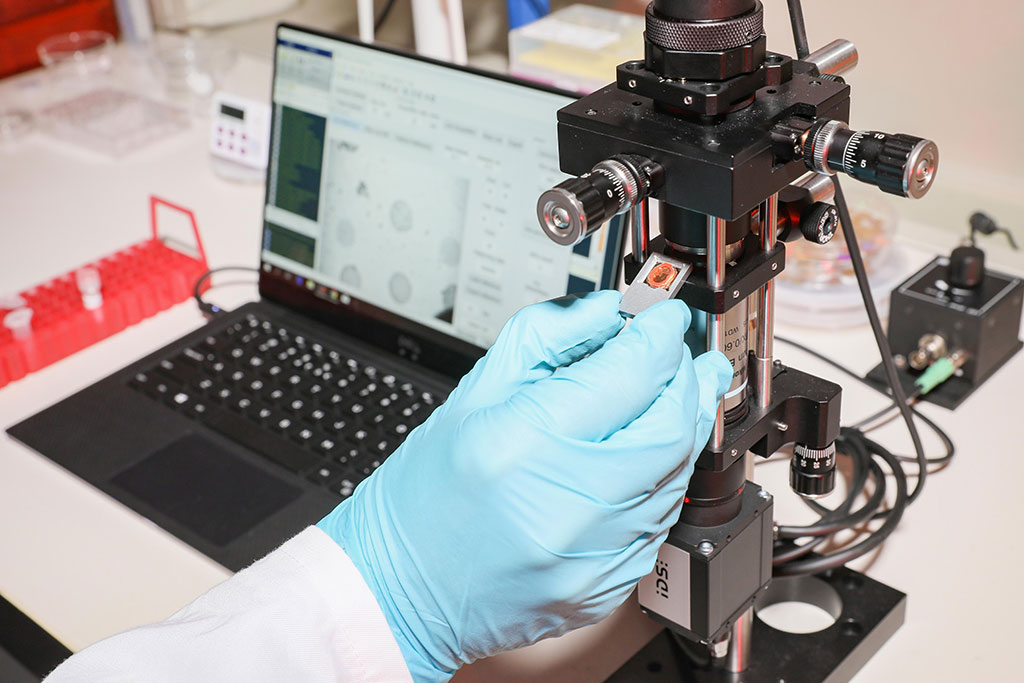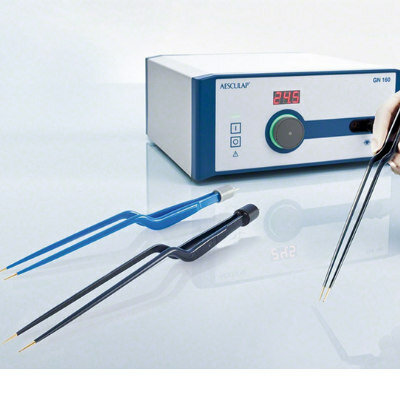Portable Nanoplasmonic Imager Detects Sepsis Faster 
|
By HospiMedica International staff writers Posted on 05 Feb 2020 |

Image: A nano-scale optical biosensor can rapidly detect sepsis (Photo courtesy of EPFL)
A highly portable device based on a nano-scale optical biosensor can rapidly detect inflammatory biomarkers in a patient's bloodstream.
Developed at Ecole Polytechnique Fédérale de Lausanne (EPFL; Switzerland), Hospital Universitari Vall dHebron (Barcelona, Spain), and Universitat Autònoma de Barcelona (UAB, Spain), the new device employs a gold-based metasurface that concentrates light around billions of nanoholes. Nanoparticles that capture the sepsis biomarkers procalcitonin (PCT) and C‐reactive protein (CRP) are distributed on the metasurface, and those that have captured biomarkers are trapped in the nanoholes. When an LED is applied, they partially obstruct the light passing through the perforated metasurface, allowing detection with a CMOS camera.
In field studies with a wide range of patient samples with sepsis, noninfectious systemic inflammatory response syndrome (SIRS), and healthy subjects, the device achieves an outstanding limit of detection of 21.3 pg mL−1 for PCT and 36 pg mL−1 for CRP. The results were validated against clinical diagnosis and currently used immunoassays, providing a performance level equivalent to the gold‐standard laboratory tests. Importantly, the plasmonic imager can enable identification of PCT levels typical of sepsis and SIRS patients in less than 15 minutes. The study was published on January 23, 2020, in Small.
“The device proved to be particularly suitable for on‐site operation due to its portability, inexpensive off‐the‐shelf optical components, and because it does not involve any moving parts or complex microfluidic elements prone to clogging,” concluded lead author Alexander Belushkin, PhD, of the EPFL Institute of BioEngineering, and colleagues. “Importantly, the sensor chips and bioassay reagents can be stored in the fridge stably over weeks and unlike previously reported optical detection schemes, do not require fluorescent tags that can be expensive, unstable, and difficult to produce.”
Sepsis is the primary cause of death in hospitals, and one of the ten leading causes of death worldwide, claiming a life every four seconds. It is associated with the body's inflammatory response to a bacterial infection and progresses extremely rapidly: every hour that goes by before it is properly diagnosed and treated increases the mortality rate by nearly 8%. Time is critical with sepsis, but the tests currently used in hospitals can take up to 72 hours to provide a diagnosis.
Related Links:
Ecole Polytechnique Fédérale de Lausanne
Hospital Universitari Vall dHebron
Universitat Autònoma de Barcelona
Developed at Ecole Polytechnique Fédérale de Lausanne (EPFL; Switzerland), Hospital Universitari Vall dHebron (Barcelona, Spain), and Universitat Autònoma de Barcelona (UAB, Spain), the new device employs a gold-based metasurface that concentrates light around billions of nanoholes. Nanoparticles that capture the sepsis biomarkers procalcitonin (PCT) and C‐reactive protein (CRP) are distributed on the metasurface, and those that have captured biomarkers are trapped in the nanoholes. When an LED is applied, they partially obstruct the light passing through the perforated metasurface, allowing detection with a CMOS camera.
In field studies with a wide range of patient samples with sepsis, noninfectious systemic inflammatory response syndrome (SIRS), and healthy subjects, the device achieves an outstanding limit of detection of 21.3 pg mL−1 for PCT and 36 pg mL−1 for CRP. The results were validated against clinical diagnosis and currently used immunoassays, providing a performance level equivalent to the gold‐standard laboratory tests. Importantly, the plasmonic imager can enable identification of PCT levels typical of sepsis and SIRS patients in less than 15 minutes. The study was published on January 23, 2020, in Small.
“The device proved to be particularly suitable for on‐site operation due to its portability, inexpensive off‐the‐shelf optical components, and because it does not involve any moving parts or complex microfluidic elements prone to clogging,” concluded lead author Alexander Belushkin, PhD, of the EPFL Institute of BioEngineering, and colleagues. “Importantly, the sensor chips and bioassay reagents can be stored in the fridge stably over weeks and unlike previously reported optical detection schemes, do not require fluorescent tags that can be expensive, unstable, and difficult to produce.”
Sepsis is the primary cause of death in hospitals, and one of the ten leading causes of death worldwide, claiming a life every four seconds. It is associated with the body's inflammatory response to a bacterial infection and progresses extremely rapidly: every hour that goes by before it is properly diagnosed and treated increases the mortality rate by nearly 8%. Time is critical with sepsis, but the tests currently used in hospitals can take up to 72 hours to provide a diagnosis.
Related Links:
Ecole Polytechnique Fédérale de Lausanne
Hospital Universitari Vall dHebron
Universitat Autònoma de Barcelona
Latest Critical Care News
- CPR Guidelines Updated for Pediatric and Neonatal Emergency Care and Resuscitation
- Ingestible Capsule Monitors Intestinal Inflammation
- Wireless Implantable Sensor Enables Continuous Endoleak Monitoring
- Pulse Oximeter Index Offers Non-Invasive Guides for Fluid Therapy
- Wearable Patch for Early Skin Cancer Detection to Reduce Unnecessary Biopsies
- 'Universal' Kidney to Match Any Blood Type
- Light-Based Technology to Measure Brain Blood Flow Could Diagnose Stroke and TBI
- AI Heart Attack Risk Assessment Tool Outperforms Existing Methods
- Smartphone Imaging System Enables Early Oral Cancer Detection
- Swallowable Pill-Sized Bioprinter Treats GI Tract Injuries

- Personalized Brain “Pacemakers” Could Help Patients with Hard-To-Treat Epilepsy
- Microscopic DNA Flower Robots to Enable Precision Medicine Delivery
- Origami Robots to Deliver Medicine Less Invasively and More Effectively
- Improved Cough-Detection Technology Aids Health Monitoring
- AI Identifies Children in ER Likely to Develop Sepsis Within 48 Hours
- New Radiofrequency Therapy Slows Glioblastoma Growth
Channels
Critical Care
view channel
CPR Guidelines Updated for Pediatric and Neonatal Emergency Care and Resuscitation
Cardiac arrest in infants and children remains a leading cause of pediatric emergencies, with more than 7,000 out-of-hospital and 20,000 in-hospital cardiac arrests occurring annually in the United States.... Read more
Ingestible Capsule Monitors Intestinal Inflammation
Acute mesenteric ischemia—a life-threatening condition caused by blocked blood flow to the intestines—remains difficult to diagnose early because its symptoms often mimic common digestive problems.... Read more
Wireless Implantable Sensor Enables Continuous Endoleak Monitoring
Endovascular aneurysm repair (EVAR) is a life-saving, minimally invasive treatment for abdominal aortic aneurysms—balloon-like bulges in the aorta that can rupture with fatal consequences.... Read more
Wearable Patch for Early Skin Cancer Detection to Reduce Unnecessary Biopsies
Skin cancer remains one of the most dangerous and common cancers worldwide, with early detection crucial for improving survival rates. Traditional diagnostic methods—visual inspections, imaging, and biopsies—can... Read moreSurgical Techniques
view channel
Robotic Assistant Delivers Ultra-Precision Injections with Rapid Setup Times
Age-related macular degeneration (AMD) is a leading cause of blindness worldwide, affecting nearly 200 million people, a figure expected to rise to 280 million by 2040. Current treatment involves doctors... Read more
Minimally Invasive Endoscopic Surgery Improves Severe Stroke Outcomes
Intracerebral hemorrhage, a type of stroke caused by bleeding deep within the brain, remains one of the most challenging neurological emergencies to treat. Accounting for about 15% of all strokes, it carries... Read morePatient Care
view channel
Revolutionary Automatic IV-Line Flushing Device to Enhance Infusion Care
More than 80% of in-hospital patients receive intravenous (IV) therapy. Every dose of IV medicine delivered in a small volume (<250 mL) infusion bag should be followed by subsequent flushing to ensure... Read more
VR Training Tool Combats Contamination of Portable Medical Equipment
Healthcare-associated infections (HAIs) impact one in every 31 patients, cause nearly 100,000 deaths each year, and cost USD 28.4 billion in direct medical expenses. Notably, up to 75% of these infections... Read more
Portable Biosensor Platform to Reduce Hospital-Acquired Infections
Approximately 4 million patients in the European Union acquire healthcare-associated infections (HAIs) or nosocomial infections each year, with around 37,000 deaths directly resulting from these infections,... Read moreFirst-Of-Its-Kind Portable Germicidal Light Technology Disinfects High-Touch Clinical Surfaces in Seconds
Reducing healthcare-acquired infections (HAIs) remains a pressing issue within global healthcare systems. In the United States alone, 1.7 million patients contract HAIs annually, leading to approximately... Read moreHealth IT
view channel
Printable Molecule-Selective Nanoparticles Enable Mass Production of Wearable Biosensors
The future of medicine is likely to focus on the personalization of healthcare—understanding exactly what an individual requires and delivering the appropriate combination of nutrients, metabolites, and... Read moreBusiness
view channel
Philips and Masimo Partner to Advance Patient Monitoring Measurement Technologies
Royal Philips (Amsterdam, Netherlands) and Masimo (Irvine, California, USA) have renewed their multi-year strategic collaboration, combining Philips’ expertise in patient monitoring with Masimo’s noninvasive... Read more
B. Braun Acquires Digital Microsurgery Company True Digital Surgery
The high-end microsurgery market in neurosurgery, spine, and ENT is undergoing a significant transformation. Traditional analog microscopes are giving way to digital exoscopes, which provide improved visualization,... Read more
CMEF 2025 to Promote Holistic and High-Quality Development of Medical and Health Industry
The 92nd China International Medical Equipment Fair (CMEF 2025) Autumn Exhibition is scheduled to be held from September 26 to 29 at the China Import and Export Fair Complex (Canton Fair Complex) in Guangzhou.... Read more














